Exhibition at Cycladic museum to explore Picasso's "dialogue" with ancient Greek art
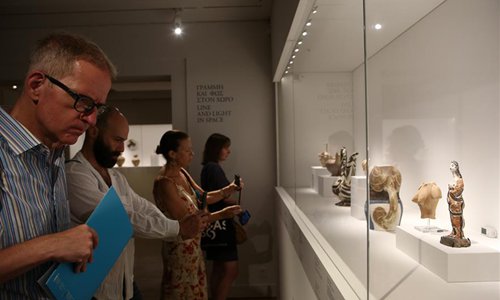
Visitors view works of art at the media preview of "Picasso and Antiquity. Line and Clay" at the Museum of Cycladic Art in Athens, Greece, June 19, 2019. A rare exhibition about Pablo Picasso and his inspiration from ancient Greek art is to open here at the Museum of Cycladic Art on Thursday. (Xinhua/Marios Lolos)
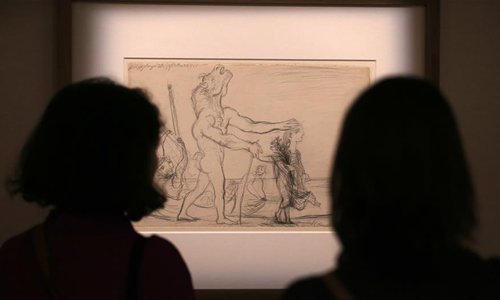
Visitors view a drawing at the media preview of "Picasso and Antiquity. Line and Clay" at the Museum of Cycladic Art in Athens, Greece, June 19, 2019. A rare exhibition about Pablo Picasso and his inspiration from ancient Greek art is to open here at the Museum of Cycladic Art on Thursday. (Xinhua/Marios Lolos)
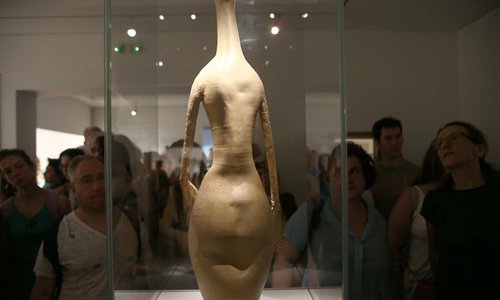
Visitors view a work of art at the media preview of "Picasso and Antiquity. Line and Clay" at the Museum of Cycladic Art in Athens, Greece, June 19, 2019. A rare exhibition about Pablo Picasso and his inspiration from ancient Greek art is to open here at the Museum of Cycladic Art on Thursday. (Xinhua/Marios Lolos)
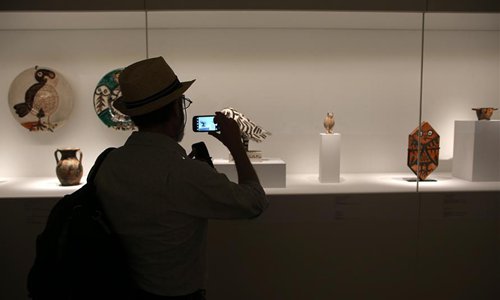
A visitor takes photos at the media preview of "Picasso and Antiquity. Line and Clay" at the Museum of Cycladic Art in Athens, Greece, June 19, 2019. A rare exhibition about Pablo Picasso and his inspiration from ancient Greek art is to open here at the Museum of Cycladic Art on Thursday. (Xinhua/Marios Lolos)
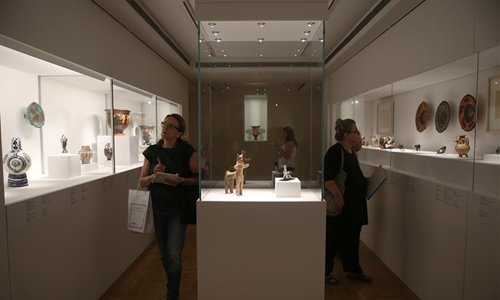
Visitors view works of art at the media preview of "Picasso and Antiquity. Line and Clay" at the Museum of Cycladic Art in Athens, Greece, June 19, 2019. A rare exhibition about Pablo Picasso and his inspiration from ancient Greek art is to open here at the Museum of Cycladic Art on Thursday. (Xinhua/Marios Lolos)
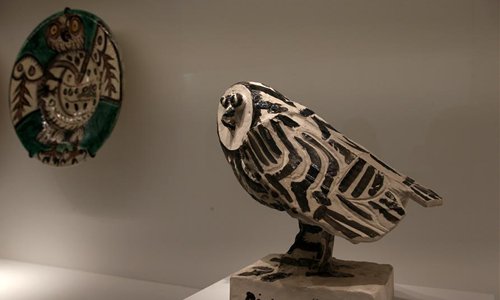
Photo taken on June 19, 2019 shows works of art at the media preview of "Picasso and Antiquity. Line and Clay" at the Museum of Cycladic Art in Athens, Greece. A rare exhibition about Pablo Picasso and his inspiration from ancient Greek art is to open here at the Museum of Cycladic Art on Thursday. (Xinhua/Marios Lolos)
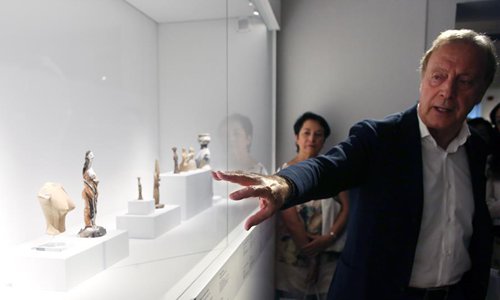
Nicholas Stampolidis (R), director of the Museum of Cycladic Art, guides visitors at the media preview of "Picasso and Antiquity. Line and Clay" at the Museum of Cycladic Art in Athens, Greece, June 19, 2019. A rare exhibition about Pablo Picasso and his inspiration from ancient Greek art is to open here at the Museum of Cycladic Art on Thursday. (Xinhua/Marios Lolos)
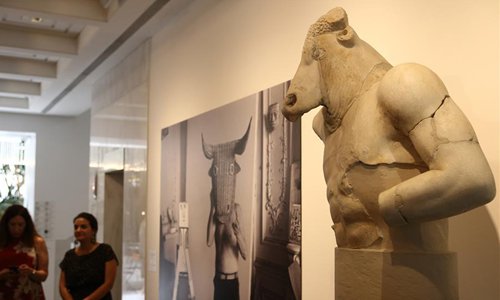
Visitors are seen at the media preview of "Picasso and Antiquity. Line and Clay" at the Museum of Cycladic Art in Athens, Greece, June 19, 2019. A rare exhibition about Pablo Picasso and his inspiration from ancient Greek art is to open here at the Museum of Cycladic Art on Thursday. (Xinhua/Marios Lolos)
A rare exhibition about Pablo Picasso and his inspiration from ancient Greek art is to open here at the Museum of Cycladic Art on Thursday.Sixty-eight ceramics and drawings by Picasso, one of the greatest 20th century artists, are put on display next to 67 ancient Greek artefacts, offering a unique opportunity for visitors to discover strong links of his work to antiquity, organizers told a press conference here on Wednesday.
Entitled "Picasso and Antiquity. Line and Clay", the exhibition will last till October 20, 2019. It is part of a series of art exhibitions under the theme "Divine Dialogues" the Greek museum organizes this year to highlight the influence of ancient art on contemporary artists.
"As Picasso stated, if a work of art cannot live in the present, it should not be considered as work of art. Can anyone doubt that ancient Greek art is still alive today and a source of inspiration?" said Sandra Marinopoulou, president of the Museum of Cycladic Art, during the briefing.
"Obviously Picasso was more than interested in mythology and antiquity. As a modern artist he had always been looking at ancient art and was inspired by ancient art," Bernard Ruiz Picasso, son of the artist and co-president of the Fundación Almine y Bernard Ruiz-Picasso para el Arte, added.
Picasso is famous for his paintings, but his drawings, engravings, and pottery are little known to the wider public and these are closely related to antiquity, inspired by ancient Greece and ancient Mediterranean civilizations in general, the exhibition's curators, Prof. Nicholas Stampolidis, director of the Museum of Cycladic Art, and art historian Olivier Berggruen, agreed.
The exhibition features Picasso's works created between the 1920s and 1960s that depict marine creatures, animals, human figures, mythological beasts (the Minotaur and centaurs), and scenes inspired by ancient Greek tragedy and comedy, conversing for the first time with ancient works of art dating from Prehistory (from c. 3200 BC) to the Late Roman period (to the mid-3rd century AD), the experts explained.
"If one noted on a piece of paper all of my itineraries and connected them with a line, they would probably draw a Minotaur," the Spanish artist had once said, Stampolidis recalled.
Picasso was referring to the part-man, part-bull mythical creature which according to Greek mythology was guarding the labyrinth on Crete island and was killed by hero Theseus.
Antiquity provided inspiration for the artist from the outset, from his early training in academic drawing under his father at the Fine Arts Academy in Barcelona to his travels across the Med, his visits to European museums, in the books he read, or during his talks with Greek-French art historian, critic, collector and publisher Christian Zervos and French novelist, poet, visual artist and critic Jean Cocteau, Stampolidis added.
"Picasso would go back to the Louvre, back to the books by Zervos and (Greek publisher, art critic and collector) Teriade and others and always find new inspiration from Greece, because Greece is inspiration for all of us," Berggruen said.
Picasso's creations for the Athens exhibition come from museums, including Fundación Almine y Bernard Ruiz-Picasso para el Arte (FABA), Musée National Picasso - Paris, Musée Picasso Antibes, Museo Picasso Malaga, Museum Berggruen (Berlin), foundations and private collections.
The antiquities come from 15 Greek museums, such as the National Archaeological Museum, as well as the Cyprus Museum and other collections.
There is always a new aspect waiting to be discovered in Picasso's work and his relationship with antiquity and Greece is of particular interest, Berggruen added.
The Athens exhibition is also part of the "Picasso-Mediterranée" project, a series of exhibitions which started in 2017 and will conclude at the end of this year, aimed to draw focus on the artist's "relationship" with the Mediterranean culture, according to Camille Frasca, head of project "Picasso-Méditerranée", Musée National Picasso - Paris.
The project, which is a Musée National Picasso - Paris initiative, includes a total of 45 exhibitions in cooperation with 70 cultural institutions. The exhibition at the Cycladic Museum is the 40th.
"Each exhibition and especially this one at the Cycladic art museum is very important to understand and see the important ancient Mediterranean art links in the modern art of Picasso," Frasca said.